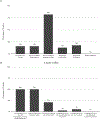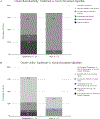Current Approaches in Computational Psychiatry for the Data-Driven Identification of Brain-Based Subtypes
- PMID: 36841702
- PMCID: PMC10038896
- DOI: 10.1016/j.biopsych.2022.12.020
Current Approaches in Computational Psychiatry for the Data-Driven Identification of Brain-Based Subtypes
Abstract
The ability of our current psychiatric nosology to accurately delineate clinical populations and inform effective treatment plans has reached a critical point with only moderately successful interventions and high relapse rates. These challenges continue to motivate the search for approaches to better stratify clinical populations into more homogeneous delineations, to better inform diagnosis and disease evaluation, and prescribe and develop more precise treatment plans. The promise of brain-based subtyping based on neuroimaging data is that finding subgroups of individuals with a common biological signature will facilitate the development of biologically grounded, targeted treatments. This review provides a snapshot of the current state of the field in empirical brain-based subtyping studies in child, adolescent, and adult psychiatric populations published between 2019 and March 2022. We found that there is vast methodological exploration and a surprising number of new methods being created for the specific purpose of brain-based subtyping. However, this methodological exploration and advancement is not being met with rigorous validation approaches that assess both reproducibility and clinical utility of the discovered brain-based subtypes. We also found evidence for a collaboration crisis, in which methodological exploration and advancements are not clearly grounded in clinical goals. We propose several steps that we believe are crucial to address these shortcomings in the field. We conclude, and agree with the authors of the reviewed studies, that the discovery of biologically grounded subtypes would be a significant advancement for treatment development in psychiatry.
Keywords: Biomarkers; Biotypes; Clinical utility; Neuroimaging; Precision medicine; Reproducibility.
Copyright © 2022 Society of Biological Psychiatry. Published by Elsevier Inc. All rights reserved.
Conflict of interest statement
Disclosures
Dr. Damien Fair is co-founder, Director, and equity holder of Nous Imaging, which has licensed the FIRMM motion monitoring software. These interests have been reviewed and managed by the University of Minnesota in accordance with its Conflict-of-Interest policies. LRB, EF and AZ reported no biomedical financial interests or potential conflicts of interest.
Figures




References
-
- Insel T, Cuthbert B, Garvey M, Heinssen R, Pine DS, Quinn K, et al. (2010): Research domain criteria (RDoC): toward a new classification framework for research on mental disorders. Am J Psychiatry 167: 748–751. - PubMed
Publication types
MeSH terms
Grants and funding
LinkOut - more resources
Full Text Sources
Miscellaneous

